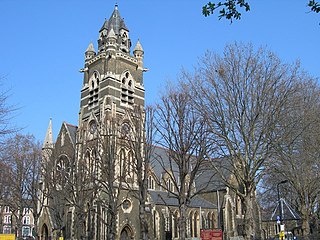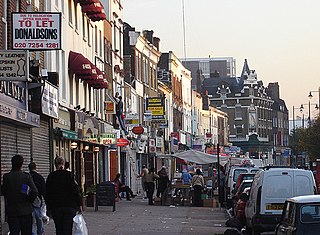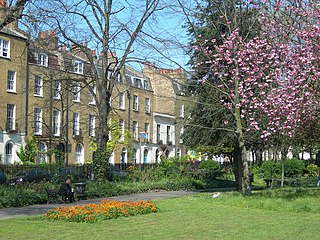
Dalston Square is a largely residential complex located just off Kingsland Road near Dalston Junction station in Dalston, part of the London Borough of Hackney. It includes approximately 500 homes, a library, public space, shops and restaurants. [1]

Dalston Square is a largely residential complex located just off Kingsland Road near Dalston Junction station in Dalston, part of the London Borough of Hackney. It includes approximately 500 homes, a library, public space, shops and restaurants. [1]
Dalston Square was originally the site of a former hippodrome and music hall, which opened in 1886 under the name "Dalston Circus". After a series of name changes, the curtain went down on live theatre in 1920 when the venue was changed into a cinema. It operated successfully under a variety of names, the last of which - the Gaumont Theatre - is now remembered in the name of one of the residential towers, until 1960. [2] After a brief stint as a warehouse and car sale room, the building once again opened its doors to entertainment audiences when, in 1966 it was reopened as the Four Aces Club a music and recreational space dedicated to celebrating Afro Caribbean music. It was famous for its Reggae, Roots, Soul and R&B and hosted acts The Ronettes, Desmond Dekker and Ben E. King. In the 1980s, it changed hands again and became the Labyrinth nightclub [3] It closed its doors for good in 1998 and, despite objections from the local community and a number of conservation organisations, was demolished in 2007. [4]
The London Development Agency and the landowners – Hackney Council and Transport for London – developed the two sites at Dalston Lane South and Dalston Junction in conjunction with Barratt Homes.
Located in Dalston Square is the Dalston C. L. R. James Library, which was the first library to open in Hackney for 20 years. [5]
In 2016, Telford Homes redeveloped the Holy Trinity School located at the southeastern edge of Dalston Square into a mixed building called "The Vibe" which incorporates a bigger school as well as 101 flats. [6] [7]

The London Borough of Hackney is a London borough in Inner London, England. The historical and administrative heart of Hackney is Mare Street, which lies 5 miles (8 km) north-east of Charing Cross. The borough is named after Hackney, its principal district. Southern and eastern parts of the borough are popularly regarded as being part of east London that spans some of the traditional East End of London with the northwest belonging to north London. Its population is estimated to be 281,120.

Dalston is an area of East London, in the London Borough of Hackney. It is four miles northeast of Charing Cross. Dalston began as a hamlet on either side of Dalston Lane, and as the area urbanised the term also came to apply to surrounding areas including Kingsland and Shacklewell, all three of which being part of the Ancient Parish of Hackney.

Homerton is an area in London, England, in the London Borough of Hackney. It is bordered to the west by Hackney Central, to the north by Lower Clapton, in the east by Hackney Wick, Leyton and by South Hackney to the south. In 2019, it had a population of 14,658 people. In terms of ethnicity it was 43.9% White, 33.0% Black, 10.9% Asian and 7.8% Mixed. It covered an area of 0.830 sq kilometres. Homerton ward on Hackney Borough Council is currently represented by three Labour councillors. There are fifty listed buildings located within the boundaries of the ward.

Old Street is a 1-mile (1.6 km) street in inner north-east Central London, England that runs west to east from Goswell Road in Clerkenwell, in the London Borough of Islington, via St Luke's and Old Street Roundabout, to the crossroads where it meets Shoreditch High Street (south), Kingsland Road (north) and Hackney Road (east) in Shoreditch in the London Borough of Hackney.

Wilmslow Road is a major road in Manchester, England, running from Parrs Wood northwards to Rusholme where it becomes the Oxford Road. The name of the road changes again to Oxford Street when it crosses the River Medlock before reaching Manchester city centre.

Kingsland Road is the name given to an East London stretch of the A10 road within the London Borough of Hackney in England. The A10 was originally a Roman Road better known as Ermine Street or sometimes the Old North Road.

Hackney Central is a sub-district of Hackney in the London Borough of Hackney in London, England and is four miles (6.4 km) northeast of Charing Cross.

Kingsland was a small road-side settlement centred on Kingsland High Street on the Old North Road, around the junction with Dalston Lane. It is no longer discernable as a separate settlement, though the historic street pattern remains. Since the opening of Dalston Junction station in 1865, the area has become known as Dalston, which was originally a separate hamlet further east. Historically part of the county of Middlesex, the area is within the London Borough of Hackney.

Crossrail 2 is a suspended proposal for a hybrid commuter rail and rapid transit route in South East England, running from nine stations in Surrey to three in Hertfordshire, providing a new North–South rail link across Greater London. It would connect the South West Main Line to the West Anglia Main Line, via Victoria and King's Cross St Pancras. The intent was to alleviate severe overcrowding that would otherwise occur on commuter rail routes into Central London. When first proposed, the hope was for construction to start around 2023, with the new line opening from the early 2030s. The project's cost has been estimated at £31.2 billion.

East Cross Route (ECR) is a dual-carriageway road constructed in east London as part of the uncompleted Ringway 1 as part of the London Ringways plan drawn up the 1960s to create a series of high speed roads circling and radiating out from central London. The road was constructed between 1967 and 1973 and runs from Hackney Wick in north-east London, through the Blackwall Tunnel, to Kidbrooke in south-east London. The ECR was initially designated as part of the A102, but has, subsequently, been partially renumbered so that sections of it are now the A2 and A12.

Clapton Square is the second largest garden square in the London Borough of Hackney, located in Lower Clapton, Clapton. It is lined by buildings on three sides. Its Conservation Area designated in 1969 – extended in 1991 and 2000 – takes in a larger green space separated by a stretch of open road: St John's Gardens. Those gardens have the tallest and largest building visible from all parts of the square's garden, the Church of St John-at-Hackney, rebuilt in 1792-97 which contains older monuments. Two sides of the square are lined with tall, partly stone-dressed, classical, Georgian terraced houses.

The artsdepot is a multi-purpose cultural centre located in North Finchley, in the London borough of Barnet. It was officially opened on 23 October 2004 for the enjoyment and development of the arts in North London.

Gaumont State Cinema is a Grade II* listed Art Deco theatre located in Kilburn, a district in northwest London.

John Stanley Coombe Beard FRIBA, known professionally as J. Stanley Beard, was an English architect known for designing many cinemas in and around London.

The Tivoli Theatre of Varieties was a popular English theatre based in the Strand, West London. It was designed by Charles Phipps and was built during 1889–90 at a cost of £300,000. It was constructed on the former site of the Tivoli Beer Garden and Restaurant. In the consortium that financed the project was the actor Edward O'Connor Terry. The hall opened on 24 May 1890 and was located opposite the Adelphi Theatre.

Mare Street is a street in the London Borough of Hackney. It has existed since the 15th century, when it was one of the first roads at the centre of the parish. It was then known as Merestret. The word mere was either the Old English mǣre meaning a boundary — referring to the boundary with the parish of Stepney — or mere, a large pond which was fed by Hackney Brook.

The Rio Cinema is a Grade II listed independent Art Deco cinema in Dalston, east London. It is a popular independent cinema located on Kingsland High Street, with a history stretching back over 100 years. The Rio added a second screen in the unused basement space in December 2017.

The Four Aces Club was a pioneering music and recreational space on Dalston Lane in Dalston, London. Based in a building that had formerly been the North London Colosseum and Amphitheatre and then a cinema, in the 1960s and 1970s the club became one of the first venues to play black music in the United Kingdom. It was credited with playing a significant "role in the evolution of reggae into dance music, from ska, to rocksteady, to dub, to lovers, to dancehall and the evolution of jungle." Many notable Afro-Caribbean musicians appeared at the Four Aces, which was often referred to as "the jewel in Dalston's crown". As well as reggae and dub artists, its clientele over the years including stars such as Bob Marley, Stevie Wonder and Jimmy Cliff.

The Embassy Cinema is a former cinema in the town of Chadwell Heath, Greater London. It was once known, among locals, as The Gaumont. It was designed in an art deco style, with a streamline moderne interior, by Harry Weston in 1934. The building is situated on the border of Redbridge and Barking & Dagenham, in the Chadwell Heath District Centre. The cinema closed in 1966 and became a Bingo Hall. In 2015, following the closure of the Bingo Hall, it was then used as a wedding hall/banqueting suite. The building was listed as an Asset of Community Value by the 'Chadwell Heath South Residents' Association' in August 2017 and is currently the focus of a major cinema restoration project.
51°32′44.28″N0°4′27.71″W / 51.5456333°N 0.0743639°W